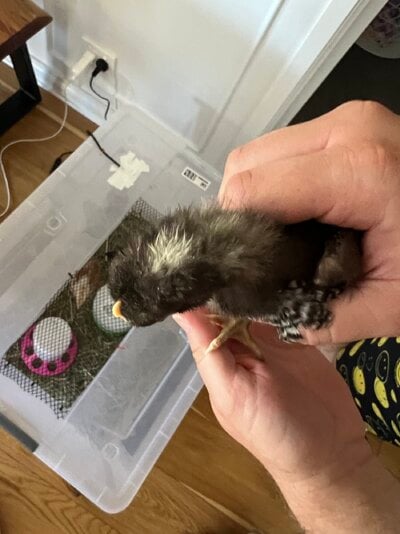At this point, it seems to be a cockerel to me. The only pullet-like trait there is the dark wash on the legs, but depending on the line, it can still be present on cockerels. The feathering being slow looks male. Coloring appears more male as well. Pullets feather out faster than cockerels. Having raised that breed variety for 20 years, I've sexed more than my fair share of Barred Rocks. Even being highly experienced with both hatchery stock and quality breeder stock, I've had a couple of incorrect guesses over the years. You can usually tell the sex of BRs as soon as they're dried off from hatch. Males have a more scattered, larger head spot and some "frosting" down the neck (but the head spot fades in a couple to three weeks, not as definitive), are lighter in their fluff and barring, having two barring genes instead of one; pullets have only one barring gene so are darker with more regular, smaller head spots as well as a dark wash down the leg fronts. Males can have a bit of that dark wash, but it's usually just a bit here and there, not all the way down the leg. Yours seems to be feathering more like a male.
Sexing is an art with barred varieties, not truly a science. You take the three traits I mentioned, head spot character, down color (true black or faded black), presence or lack of dark wash down the legs, together to form your opinion. Still, some can have confusing sex traits and occasionally, you'll get a lighter pullet or a darker cockerel or one with a head spot that reads opposite to the sex. Generally by six weeks, we see some pink in a cockerel's comb. Everyone on BYC said one of my first BRs in my original flock was a male...until she didn't develop a comb. She was much lighter than her coop mate pullet from the same batch of chicks. And I once named a BR cockerel Zoe, until he showed himself a bit better. He became Zane, the rooster I still call the chicken love of my life.
Some hatchery stock is harder to sex than good breeder stock, IMO, because of the lesser overall quality of the breeds and the proper breed traits, but you still use the same traits to assess the sex.
Let us know how it turns out!
Sexing is an art with barred varieties, not truly a science. You take the three traits I mentioned, head spot character, down color (true black or faded black), presence or lack of dark wash down the legs, together to form your opinion. Still, some can have confusing sex traits and occasionally, you'll get a lighter pullet or a darker cockerel or one with a head spot that reads opposite to the sex. Generally by six weeks, we see some pink in a cockerel's comb. Everyone on BYC said one of my first BRs in my original flock was a male...until she didn't develop a comb. She was much lighter than her coop mate pullet from the same batch of chicks. And I once named a BR cockerel Zoe, until he showed himself a bit better. He became Zane, the rooster I still call the chicken love of my life.
Some hatchery stock is harder to sex than good breeder stock, IMO, because of the lesser overall quality of the breeds and the proper breed traits, but you still use the same traits to assess the sex.
Let us know how it turns out!






